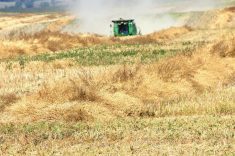REGINA (Staff) – Farmers often ignore advice that could prevent injuries or help their health, say health workers in Alberta and Saskatchewan.
“Farmers are getting hurt not because they lack the knowledge” of safety measures, said Solomon Kyeremanteng of Alberta’s health department. “They know. So how do we motivate them to do the things they know will be good for them and let them stay alive and healthy?”
Saskatchewan and Alberta governments have come up with radically different answers to that question.
A health district in Saskatchewan is assigning an occupational health nurse specifically to agriculture, while Kyeremanteng said Alberta is moving in the opposite direction.
Read Also

Alberta researcher helps unlock the economics of farming
Lethbridge Polytechnic researcher helping agriculture producers with decision-making tools in economic feasibility
Kyeremanteng said the best way to reach producers is through newspapers, TV and radio.
“Sitting them down and preaching to them is not the answer,” he said. He said since producers know much of their behavior on the farm is unnecessarily risky, giving them information repeating that serves no purpose. What is needed is behavior modification, he said.
Kyeremanteng pointed to ParticipAction, a fitness program pushed by the federal government since the 1970s, as an example of how people across the country could be convinced to become more healthy.
Using advertising techniques to sell safety is likely to be more successful than “teaching courses or handing out pamphlets.”
He also said it is cheaper.
The approach taken by the North Valley Health District in central Saskatchewan will emphasize a more personal element. Health nurse Sharon Clark will work with local producers to fill what she said is a terrible gap in farm health knowledge.
“We need some way of gathering statistics on the smaller accidents and injuries that happen,” Clark said. “We can record fatalities. We have those numbers. But we have no way of recording minor accidents and injuries.”
Many people in Saskatchewan were shocked to hear that 26 people died from agricultural accidents in the province last year, she said. But what is equally shocking is that there are about 30 serious injuries for every fatality, she said.
“It’s phenomenal the number of farmers who have been lacerated or had their arms mangled,” she said.
She pointed to a program in the United States in which occupational health nurses in nine states amassed enough data to reveal patterns of preventable injuries.
In one horrifying example, nurses discovered that a particular make and model of hay baler had scalped a number of people across the country. Knowing this, health workers could send an advisory to workers.














